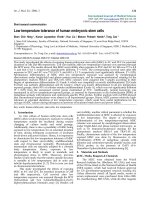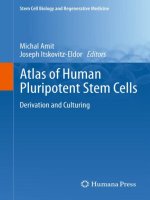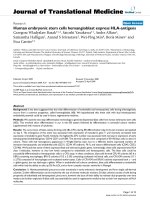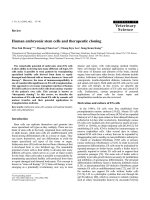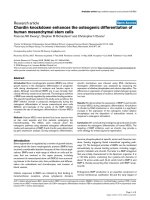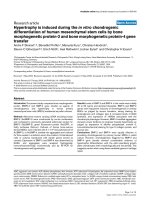Baculovirus mediated genetic modification of human embryonic stem cells
Bạn đang xem bản rút gọn của tài liệu. Xem và tải ngay bản đầy đủ của tài liệu tại đây (6.05 MB, 135 trang )
BACULOVIRUS-MEDIATED GENETIC MODIFICATION
OF HUMAN EMBRYONIC STEM CELLS
Du Juan
NATIONAL UNIVERSITY OF SINGAPORE
2008
BACULOVIRUS-MEDIATED GENETIC MODIFICATION
OF HUMAN EMBRYONIC STEM CELLS
DU JUAN
(B. Sc.)
A THESIS SUBMITTED
FOR THE DEGREE OF DOCTOR OF PHILOSOPHY
DEPARTMENT OF BIOLOGICAL SCIENCES
NATIONAL UNIVERSITY OF SINGAPORE
AND
INSTITUTE OF BIOENGINEERING AND NANOTECHNOLOGY
Jan 2008
ACKNOWLEDGMENTS
First of all, I would like to express my gratitude to my supervisor, Dr. Wang
Shu, Associate Professor, Department of Biological Science, National
University of Singapore and Group Leader, Institute of Bioengineering and
Nanotechnology, for his continuous support and patient supervision during
my entire post-graduate study period.
I would also like to acknowledge our excellent gene delivery group at the
Institute of Bioengineering and Nanotechnology for providing a fantastic
environment and an exceptional research atmosphere for the study.
Special acknowledgments go to Dr. Zeng Jieming for his patient
cooperation and many useful discussions regarding my research project, and
to Dr. Wu Chunxiao for his helpful suggestions for experiments and critical
review of this thesis.
This thesis is dedicated to my father Du Weijun and my mother Tian Lihua,
whose love, encouragement, and support have always been my greatest
inspiration.
I
TABLE OF CONTENTS
Contents
Page
ACKNOWLEDGMENTS .................................................................................. I
TABLE OF CONTENTS .................................................................................. II
SUMMARY ....................................................................................................VII
LIST OF PUBLICATIONS ..............................................................................IX
LIST OF TABLES ...........................................................................................X
LIST OF FIGURES.........................................................................................XI
ABBREVIATIONS........................................................................................XIII
CHAPTER ONE: INTRODUCTION................................................................. 1
1.1 General Introduction ........................................................................ 2
1.1.1 Human Embryonic Stem Cells.................................................. 2
1.1.2 Non-Viral Genetic Modification Systems for hES Cells ............ 3
1.1.3 Viral Vectors for Genetic Modification of hES Cells.................. 4
1.1.4 Baculovirus Vectors Mediated Gene Delivery .......................... 5
1.2 Purpose of This Study ..................................................................... 7
1.3 Specific Objectives........................................................................... 8
CHAPETR TWO: ENGINEERING TRANSGENE EXPRESSION
CASSETTES FOR EFFICIENT AND TRANSIENT BACULOVIRAL
TRANSDUCTION OF HUMAN EMBRYONIC STEM CELLS ....................... 11
2.1 Introduction .................................................................................... 12
II
2.1.1 Current Status of Transient Transgene Transfer in hES Cells 12
2.1.2 Promoters for Transgene Expression in Mammalian Cells..... 13
2.1.3 Viral Genetic Modulators ........................................................ 14
2.1.4 Objectives .............................................................................. 15
2.2 Material and Methods..................................................................... 16
2.2.1 Transfer Plasmids and Baculovirus Preparation .................... 16
2.2.2 Maintenance of hES cells and Baculoviral Transduction........ 19
2.2.3 FACS Analysis ....................................................................... 21
2.2.4 Immunocytochemistry ............................................................ 21
2.3 Results ............................................................................................ 22
2.3.1 Optimization of Baculoviral Transduction Method .................. 22
2.3.2 Baculoviral Vectors Effectively Mediate Gene Transfer to hES
Cells ................................................................................................ 24
2.3.3 Various Promoters Show Differential Efficiency for Baculoviral
Transduction of HES-1 .................................................................... 27
2.3.4 WPRE, not ITR Sequences, Efficiently Enhanced Baculoviral
Transduction of HES-1 .................................................................... 30
2.3.5 A Hybrid Promoter Further Improved Baculoviral Transduction
of HES-1.......................................................................................... 33
2.3.6 Transgene Expression Cassettes Optimized in HES-1 Also
Displayed Better Efficiency for Baculoviral Transduction of HES-3
and Differentiated HES-1 ................................................................ 35
III
2.3.7 Baculoviral transduction of hES cells was transient and had no
effect on cell proliferation in vitro..................................................... 37
2.4 Discussion ...................................................................................... 39
CHAPTER THREE: HYBRID BACULOVIRUS VECTORS FOR
LONG-TERM STABLE TRANSGENE EXPRESSION.................................. 45
3.1 Introduction .................................................................................... 46
3.1.1 Hybrid Viral Vectors................................................................ 47
3.1.2 Objectives .............................................................................. 48
3.2 Materials and Methods................................................................... 49
3.2.1 Plasmid Construction and Virus Preparation .......................... 49
3.2.2 Cell Line Maintenance and Transduction ............................... 51
3.2.3 Maintenance and Differentiation of hES cells ......................... 52
3.2.4 Viral Transduction and FACS analysis ................................... 54
3.2.5 Genomic DNA isolation and Nested PCR .............................. 55
3.2.6 TAIL-PCR ............................................................................... 58
3.3 Stable Transgene Expression is Obtained in A Cell Line and in
hES Cells: the Single-Vector Approach.............................................. 62
3.3.1 Hybrid Baculovirus Vectors Mediated Stable Transgene
Expression in NT2 Cells .................................................................. 62
3.3.2 Hybrid Baculovirus Vectors Mediated Stable Transgene
Expression in hES Cells .................................................................. 64
IV
3.3.3 Transgene Expression is Maintained During hES Cell
Differentiation .................................................................................. 67
3.3.4
Nested PCR and TAIL PCR Were Employed To Detect
Sequences Flanking the Integrated Transgene Cassette................ 70
3.4 Stable Transgene Expression is obtained in A Cell Line and in
hES Cells: A Co-transduction Approach............................................ 73
3.4.1 Sustainable transgene expression can be achieved by
co-transduction of ITR-and rep-containing baculoviral vectors........ 73
3.4.2 Nested-PCR Detection of the Transgene Integration Sites on
Chr19 in the Genomic DNA of Stably Transduced HeLa Cells........ 77
3.4.3 Hybrid Baculovirus Vectors Mediated Stable Transgene
Expression in hES Cells .................................................................. 81
3.4.4 Analysis of hES Genomic DNA Samples by Nested-PCR,
TAIL-PCR and the DNA Walking Speed Up Kit............................... 82
3.5 Discussion ...................................................................................... 84
CHAPTER FOUR: THE EFFECTS OF BACULOVIRAL TRANSDUCTION
ON HUMAN EMBRYONIC STEM CELLS .................................................... 87
4.1 Introduction and Objective ............................................................ 88
4.2 Materials and Methods................................................................... 88
4.2.1 Vector Construction and Virus Preparation ............................ 88
4.2.2 Maintenance and Differentiation of hES Cells ........................ 89
4.2.3 Viral Transduction .................................................................. 91
V
4.2.4 Reverse Transcription-PCR Analysis ..................................... 91
4.2.5 Immunohistochemistry and Karyotypic Analysis..................... 93
4.2.6 Teratoma Formation............................................................... 93
4.3 Baculoviral Transduction Has No Effects on hES Cells’ Stem
Cell Properties ...................................................................................... 94
4.3.1 Baculoviral Transduction Did Not Affect hES Cell Growth...... 94
4.3.2 Baculoviral Transduction Did Not Change hES Phenotype.... 95
4.3.3 Baculoviral Transduction Did Not Affect hES Cell Pluripotency97
4.4 Discussions .................................................................................. 103
CHAPTER FIVE: CONCLUSION ................................................................ 104
5.1 Results and Implications ............................................................. 105
5.1.1 Efficient and Controlled Transient Transgene Expression Can
be Achieved by Using Different Promoters and Genetic Modulators105
5.1.2 Hybrid Baculovirus Vectors Allow Stable Transgene
Expression .................................................................................... 106
5.1.3 Baculoviral Transduction Has No Effects on the Stem Cell
Properties of hES Cells ................................................................. 107
References Cited ....................................................................................... 109
VI
SUMMARY
The main purpose of the studies in this thesis was to explore and engineer
baculoviral vectors for the genetic modification of human embryonic stem
cells.
Although lentiviral vectors are widely used in gene transfer to human
embryonic stem cells, there is still a need for vectors and methods to achieve
efficient and safe genetic modification of these cells. Our studies employed
baculovirus vectors to mediate transgene expression, either transiently or
stably, as the tools for genetic modification.
First, we engineered the baculovirus vectors by choosing various
promoters and viral modulators to achieve desirable level of transient
transgene expression in human embryonic stem cells. Efficient gene
transfers to human embryonic stem cells were obtained after optimization of
the promoters and modulators.
Second, two elements from adeno-associate virus, ITR sequence and the
rep gene were inserted into the baculovirus vectors together with transgene
expression cassette. We achieved stable transgene expression in human
embryonic stem cells for up to 5 moths. We also characterized the integration
sites of the transgene expression cassette.
VII
Finally, the effects of the baculoviral transduction of the human embryonic
stem cells were investigated. The transduction of human embryonic stem
cells by baculovirus vectors had no effects on the cell growth and
pluripotency. The formation of teratoma in vivo further confirmed the
pluripotency of the transduced cells.
In summary, the information gained from this research suggest that
baculovirus vectors can be engineered to mediate both transient and stable
expression in human embryonic stem cells for the purpose of genetic
modification, thus facilitating the realization of the great potential of these
cells in basic researches and clinical applications.
VIII
LIST OF PUBLICATIONS
Publications:
1. Du J, Zeng J, Zhao Y, Wang S. The combined use of viral transcriptional
and
post-transcriptional
regulatory
elements
to
improve
baculovirus-mediated transient gene expression in human embryonic
stem cells. Manuscript in preparation.
2. Zeng J, Du J, Zhao Y, Palanisamy N, Wang S. Baculoviral
vector-mediated transient and stable transgene expression in human
embryonic stem cells. Stem Cells. 2007 Apr; 25(4):1055-61.
3. Ong ST, Li F, Du J, Tan YW, Wang S. Hybrid cytomegalovirus
enhancer-h1 promoter-based plasmid and baculovirus vectors mediate
effective RNA interference. Hum Gene Ther. 2005 Dec; 16(12):1404-12.
The studies presented in this thesis are based on the research work in the
above publications and manuscript.
IX
LIST OF TABLES
Table
Page
Table 2.1 Expression cassettes determine transgene expression in hES cells
transduced with baculoviral vectors……………………………………………28
Table 3.1 Nested-PCR primers used to detect of integration sites on
chromosome 19……………………………………………………………..……57
Table 3.2 Primers for TAIL-PCR………………………………………………..59
Table 3.3 TAIL-PCR programs………………………………………………….60
Table 4.1 Primers for RT-PCR analysis………………………………………..92
X
LIST OF FIGURES
Figure
Page
Figure 2.1 Transfer plasmids with different transgene expression cassette for
the production of baculovirus vectors…………………………………………18
Figure 2.2 Baculovirus-mediated transgene expressions in HES-1 cells
grown on feeders………………………………………………………………...23
Figure 2.3 Transient eGFP expression in hES cells mediated by baculoviral
vectors…………………………………………………………………………....26
Figure 2.4 Flow cytometric analysis of transgene expression in HES-1 cells
mediated by baculoviral vectors carrying different promoters………………29
Figure2.5 Flow cytometric analysis of transgene expression in HES-1 cells
mediated by baculoviral vectors carrying different expression cassette (MOI
100) ………………………………………………………………………………32
Figure2.6 Flow cytometric analysis of transgene expression in HES-1 cells
mediated by baculoviral vectors carrying various expression cassette (MOI
10) …………………………………………………………………………………34
Figure2.7 Flow cytometric analysis of transgene expression in HES-3 cells
mediated by baculoviral vectors carrying various expression
cassette…………………………………………………………………………..36
Figure 2.8 HES-1 clumps 1 - 7 days after transduction with various
baculoviral vectors respectively…………………………………………………38
Figure 3.1 Stable eGFP expression in NT2/D1 cells mediated by hybrid baculoviral
vectors ……………………………………………………………………………63
Figure 3.2 Stable eGFP expression in hES cells mediated by hybrid baculoviral
vectors ……………………………………………………………………………66
Figure 3.3 Maintenance of transgene expression after neural differentiation
of human embryonic stem (hES) cells stably transduced with a hybrid
baculovirus harboring a cytomegalovirus promoter-driven enhanced green
fluorescent protein (eGFP) gene………………………………………………69
XI
Figure 3.4 aavs1 primer binding sites on chr19………………………………71
Figure 3.5 Flow cytometric analysis of the EGFP+ population of HeLa cells
co-transduced by ITR and Rep-containing baculoviral vectors……………75
Figure 3.6 Detection of site-specific integration mediated by hybrid
baculovirus vectors in HeLa cells by nested-PCR……………………………78
Figure 3.7 Transgene and aavs1 junction sequence from HeLa cells
clone………………………………………………………………………………80
Figure 3.8 Stable expressions of a reporter gene in hES cells can be
achieved by co-transduction of hybrid baculoviral vectors…………………83
Figure 4.1 Effects of baculovirus infection using transient expression vectors
on the expression of molecular markers for hES cells and the three germ
layers in embryoid bodies……………………………………………………96
Figure 4.2 RT-PCR analysis of markers for the three germ layers of
baculovirus-transduced embryoid bodies…………………………………….98
Figure 4.3 Effects of baculovirus infection using stable expression vectors on the
expression of molecular markers and the karyotype of stably transduced hES
cells………………………………………………………………………………100
Figure 4.4 Immunostaining and teratoma formation of the baculoviral
transduced hES cells…………………………………………………………102
XII
ABBREVIATIONS
AAV
AcMNPV
adeno-associate virus
Autographa californica multiple
nucleopolyhedrovirus
Ad
adenovirus
BV
baculovirus
CAG
cytomegalovirus enhancer/chicken β actin
promoter
CMV
cytomegalovirus
eCMV
enhancer of cytomegalovirus immediate-early
gene
CNS
central nervous system
DMEM
Dulbecco’s modified eagle’s medium
EF1α
elongation factor 1α
eGFP
enhanced green fluorescent protein
ES cells
FBS
hES cells
embryonic stem cells
fetal bovine serum
human embryonic stem cells
HIV
human immunodeficiency virus
HSV
herpes simplex virus
ITR
inverted terminal repeat
XIII
MOI
multiplicity of infection
MCS
multiple cloning site
PBS
phosphate-buffered saline
pFB
pFastBac1
Pfu
plaque forming unit
PGK
phosphoglycerate kinase
TK
WPRE
thymidine kinase
woodchuck hepatitis virus posttranscriptional
regulatory element
XIV
CHAPTER ONE
INTRODUCTION
1
1.1 General Introduction
Embryonic stem (ES) cells as a renewable cell source for regenerative
medicine,
for
pharmaceutical
research
and
development
and
for
developmental biology studies, are currently the subject of intensive research.
Genetic manipulation of these cells with an effective gene delivery strategy is
of great importance in making use of the remarkable potential of ES cells.
Possible benefits of genetic manipulation include controlling differentiation of
ES cells, screening and acquiring pure populations of specific types of ES
cell-derived cells, altering antigenicity of cells to overcome immune rejection
in transplantation medicine, and providing cell sources with new functional
properties to combat specific diseases in the course of ex vivo gene therapy.
1.1.1 Human Embryonic Stem Cells
Human embryonic stem (hES) cells are cells derived from the inner cell
mass of human blastocysts. The hES cell research began with the derivation
of hES cell line and its successful culture in the laboratory (Thomson et al.,
1995). Human embryonic stem cells possess two characteristic properties,
self-renewal and differentiation capability. Self-renewal allows hES cells to be
kept in culture and passaged long-term under defined culture conditions
without loss of their pluripotency. This property of self-renewal will supply
research and clinical applications with an unlimited cell source. The other
interesting feature of hES cells is their differentiation potentials. hES cells are
2
able to differentiate into all the cell types in the body, that is, the cells are
pluripotent. These two properties make human embryonic stem cells
promising and attractive for use in regenerative medicine and studies of
human development as well as for pharmaceutical screening.
1.1.2 Non-Viral Genetic Modification Systems for hES Cells
In order to realize the great potential of hES cells, efficient and safe
methods need to be developed to deliver genes or proteins into these cells.
The delivery of genes or proteins or certain factors to give stem cells new
genetic
characteristics
is
called
genetic
modification.
The
genetic
modification of hES cells can be helpful in the differentiation and isolation of
lineage-committed cells, in tracking the process of differentiation, in gene
function analysis, and in altering immunogenecity. To achieve successful
genetic modification, safe and efficient gene delivery systems are crucial.
Non-viral and viral systems have been developed and optimized for use in
genetic manipulation.
Non-viral
delivery
systems,
using
naked
DNA
or
synthetic
oligonucleotides directly, or genes or proteins encapsulated with lipids,
peptides or polymers, are widely favored because of their safety. Low toxicity
is the most attractive advantage of the non-viral delivery systems. However,
they can only achieve a certain level of efficiency of transgene or protein
delivery, while viral vectors are well known for their high delivery efficiency.
3
Chemically based gene transfection and antibiotic selection have been
performed in order to establish stable human ES cell lines (Eiges et al., 2001),
but the method’s gene transfer efficiency and the efficiency of subsequent
homologous recombination in human ES cells are low. Electroporation, a
method of choice for introducing foreign DNA into mouse ES cells, can be
adapted for the gene transfection of human ES cells (Zwaka and Thomson,
2003). With nucleofection, an electroporation-based method using specific
transfection solution and electrical parameters to deliver plasmid DNA into the
cell nucleus, a transfection rate of 20% could be achieved in human ES cells
(Lakshmipathy et al., 2004). However, electroporation protocols that give
satisfactory transfection efficiency are usually detrimental to cells and hES
cells do not survive the procedure well (Eiges et al., 2001).
1.1.3 Viral Vectors for Genetic Modification of hES Cells
Modified viruses are also used to deliver transgenes both in vitro and in
vivo, mainly due to their high transduction efficiency. Various viruses have
been investigated and modified for use as delivery vectors, including
retroviruses, adenoviruses (Ads), adeno-associated viruses (AAVs), and
herpes simplex viruses (HSVs).
Among these commonly used viral vectors, HIV-based lentiviral vectors
were the first and most widely used viral vectors for the genetic modification
of hES cells because of their high gene delivery efficiency and their ability to
4
mediate stable transgene expression during prolonged undifferentiated
proliferation in vitro for an observation period of at least 38 weeks (Eiges et
al., 2001; Gropp et al., 2003; Ma et al., 2003). Besides lentivirus vectors,
adenoviral and adeno-associated viral (AAV) vectors are also able to infect
human ES cells (Smith-Arica et al., 2003). Although the potential application
of these viral vectors is enormous, concerns still remain over their
immunogenecity in medical use, especially with regard to recombination with
endogenous viruses, oncogenic chromosome insertion associated with
random integration, non-selective cytotoxicity and pre-existing immune
responses against the viruses. Furthermore, vector size for gene cloning may
be another limiting factor for certain applications that require large transgene
cassettes. Thus, there is still a great need for efficient and safe vectors for the
genetic modification of hES cells.
1.1.4 Baculovirus Vectors Mediated Gene Delivery
In addition to the commonly used viral vectors mentioned above, the
insect cells baculovirus Autographa californica multiple nucleopolyhedrovirus
(AcMNPV)-based vectors are relatively new and have recently emerged as a
promising gene delivery vector capable of efficiently transferring genes of
interest to diverse mammalian cell types (Ghosh et al., 2002; Kost and
Condreay, 2002). The ability of baculovirus to enter certain mammalian cell
lines was firstly reported by Volkman and Goldsmith in 1983, while no
evidence of viral gene expression was observed in their study. Later studies
5
showed that recombinant viruses containing a promoter that is active in
mammalian cells could be used to transduce such cells, and could therefore
potentially be used as gene delivery vectors for mammalian cells. Carbonell
and Miller (1987), using baculovirus with a mammalian gene expression
cassette, detected reporter enzyme activity in a human lung carcinoma cell
line. Baculoviruses with CMV promoter were shown by Condreay and
colleagues to infect a broad spectrum of cell lines (Condreay et al., 1999).
Recently, baculovirus has also been successfully used as vector to deliver
genes into the CNS (Sarkis et al., 2000).
As one of the most promising gene delivery vectors, baculovirus has a
number of advantages. First, baculovirus has a good biosafety profile. The
investigation of the interaction between baculovirus and mammalian cells has
indicated that baculovirus can enter but cannot replicate in mammalian cells
(Carbonell et al., 1985; Carbonell and Miller, 1987; Groner et al., 1984; Hartig
et al., 1992).
Thus, no particular attention needs to be paid to the risks
associated with replication-competent virus, a major problem in the use of
adenovirus vectors as in vivo gene delivery vectors. However, further studies
will be required to determine whether any of the viral genes are expressed in
mammalian cell (Boyce and Bucher, 1996). Second, baculovirus can
accommodate large insertions (>20 kb). The rod-shaped AcMNPV has a
double-stranded, circular DNA about 130 kb in size and the nucleocapsid
structure can accommodate up to 100 kb of foreign DNA. This enables the
6
delivery of large functional gene or of multiple genes simultaneously.
Third,
baculovirus shows broad cell-type tropism. More than 40 commonly used cell
lines, including some primary cultures, have been reported to be successfully
transduced (Ghosh et al., 2002; Kost and Condreay, 2002).
Moreover,
baculovirus is non-cytotoxic even it was used at high multiplicity of infection
(MOI).
Fourth, baculovirus is simple to manipulate and produce. The
AcMNPV vectors are helper virus independent; thus, it is relatively easy to
construct baculovirus vector with various transgene cassette and obtain large
quantities of high-titer virus stock.
Although lentivirus vectors are the most successfully and widely used
vectors for the genetic modification of human embryonic stem cells, the
random nature of their chromosomal integration has raised safety concerns
and the cloning capacity limitation of lentivirus vectors limits the size of the
transgene that can be delivered. Therefore, new vectors that can mediate
efficient and safe gene transfer to hES cells are needed. Based on the
advantages of baculovirus vectors as described above, in this study, we
undertook this study to investigate the suitability of baculovirus as a viral vector
for the genetic modification of hES cells.
1.2 Purpose of This Study
7
This thesis will focus on the exploration of baculovirus as a vector for the
genetic modification of hES cells, both for transient transgene expression and
for long-term transgene expression.
First, we constructed baculoviral vectors containing various promoters
and viral modulators to achieve different transduction efficiencies and
transgene expression intensities in hES cells. Second, we constructed
baculovirus vectors to which we added two AAV elements to mediate stable,
prolonged transgene expressions and investigated chromosome integration
sites to address the genotoxicity of these hybrid viral vectors. Third, the
effects of baculoviral vectors were examined using various approaches in
vitro and in vivo to test the effects of this viral vector on the proliferation and
differentiation of hES cells.
1.3 Specific Objectives
The main investigation of this research can be organized into three parts:
1. Baculovirus was firstly demonstrated to mediate transgene expression
in human embryonic stem cells and baculovirus vectors were then
genetically engineered with choice of promoters and viral modulators to
achieve various delivery efficiencies and different level of transgene
expression as vectors for transient transgene expression.
2. Baculoviral vectors that incorporated the two AAV elements were
constructed to become hybrid viral vector and stable transgene
8
expression by these hybrid vectors were observed for a prolonged period
and characterized.
3. The effects of baculoviral transduction on hES cells were investigated
to determine whether the baculovirus could be used as safe viral vector
for the genetic modification of ES cell. In vitro and in vivo assays were
used to test the effects of baculoviral transduction on the self-renewal and
differentiation properties of ES cells.
This study demonstrated that baculovirus is an efficient and safe vector
for the genetic modification of hES cells both for transient transgene
expression and for stable transgene expression, thus making baculovirus an
alternative viral vector (if not better than lentiviral vectors), for the genetic
modification of ES cells. By incorporating different promoters and viral
modulators or transgenes, baculoviruses can be used to achieve gene
transfer into hES cell thus facilitating stem cell research. In addition,
baculovirus can be employed to deliver factors or proteins that may direct the
differentiation of hES cells to obtain specific lineages. Moreover, baculovirus
could be used to deliver functional or therapeutic genes into human
embryonic stem cells and their derivatives. The genetically modified hES
cells and derivatives could be probably be applied in cell-based therapy to
restore lost functions, diminish abnormal cell population or repair damaged
tissues.
9
